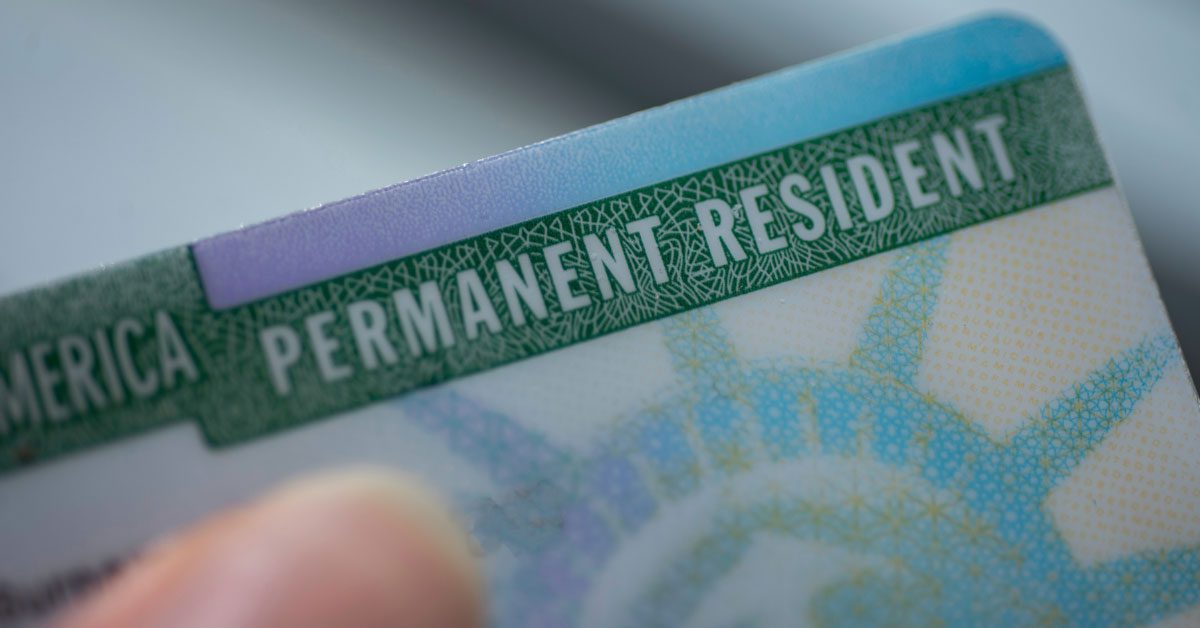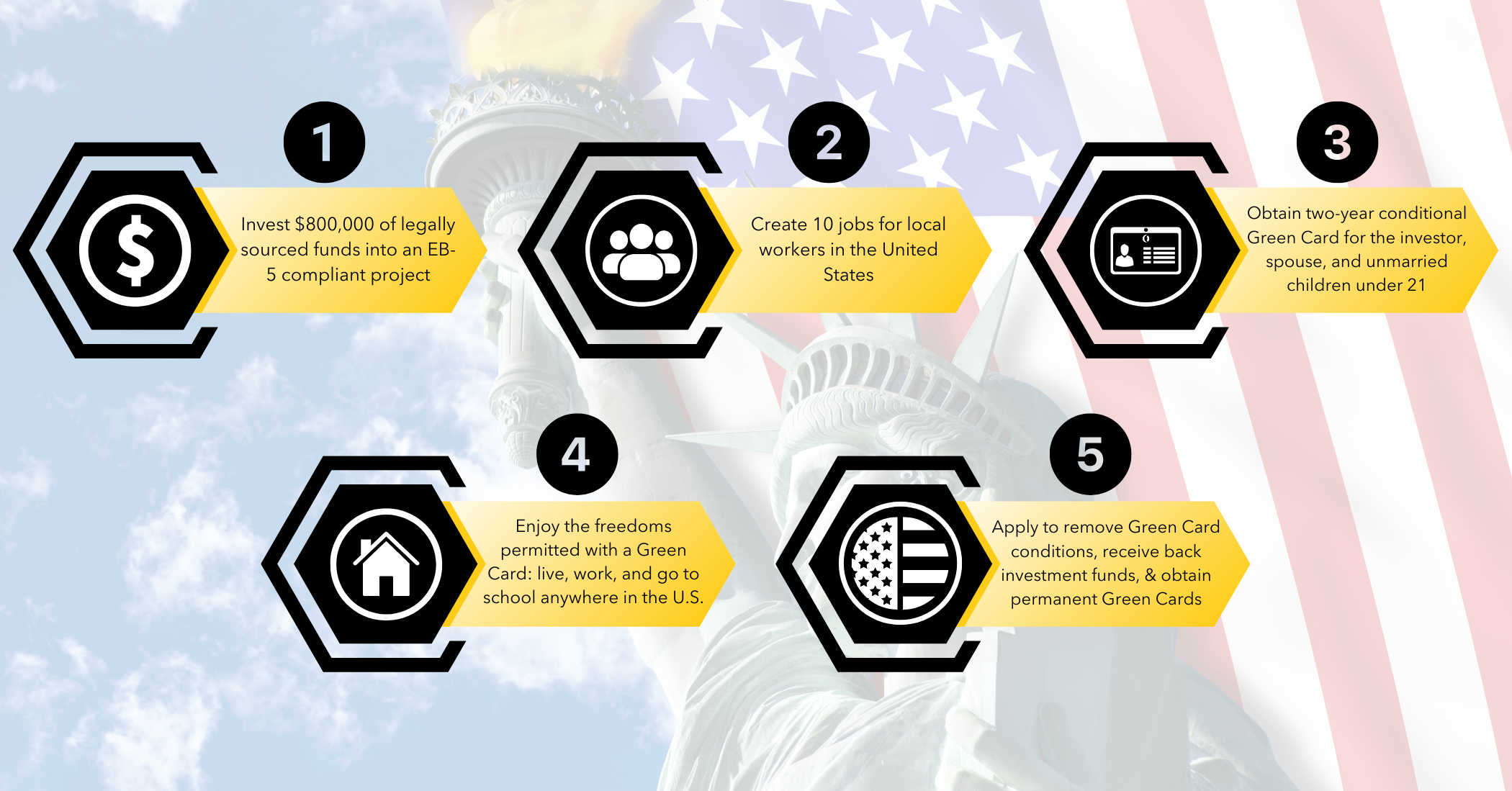EB-5 Visa Explained: Exactly How to Get a Visa With Financial Investment
The EB-5 Visa program offers an unique opportunity for international investors seeking U.S. permanent residency via an organized financial investment technique. With particular eligibility criteria and investment limits, the process needs mindful consideration and tactical planning. Understanding the nuances of the application process, including the differences in between local facilities and straight investments, is crucial for potential candidates. As this path unfolds, potential financiers have to navigate different benefits and obstacles that accompany it. What are the vital elements that can influence the success of an EB-5 application?
Summary of EB-5 Visa
The EB-5 Visa program, developed to boost the united state economic climate via international financial investment, offers a pathway to long-term residency for eligible financiers and their family members. Established by the Immigration Act of 1990, the program intends to draw in foreign funding to create jobs and enhance economic development in the United States. Investors who add a minimum quantity to an approved job can look for this visa, therefore enabling them to purchase numerous industries, including genuine estate, infrastructure, and various other commercial business.
The EB-5 program is particularly appealing as a result of its dual advantages: an opportunity for financial rois and the capacity for united state citizenship. By buying targeted employment locations (TEAs), which are specified as rural regions or areas with high unemployment, financiers may get a lowered financial investment threshold. The program requires the development of at the very least ten full time tasks for united state workers as a direct result of the financial investment. Effective applicants get a conditional visa for two years, after which they can apply for permanent residency, provided they meet all program demands. This path has actually gathered attention from investors internationally, making it a crucial part of united state migration plan.
Eligibility Standards
To qualify for the EB-5 Visa, financiers should fulfill particular eligibility requirements that ensure their financial investment contributes to task creation and economic development in the USA - EB-5 Investment Amount. Candidates have to invest a minimum of $1 million in a brand-new commercial business, or $500,000 if the financial investment is made in a targeted work location (TEA), which is commonly identified by high unemployment or rural areas.
Additionally, the venture must produce or protect at the very least ten full time jobs for qualifying U.S. employees within 2 years of the capitalist's admission to the USA. Investors are also needed to show that their investment funds were obtained with lawful methods, providing evidence such as tax returns and bank statements.
An additional critical requirement is that the investment has to remain in a for-profit organization entity that was established after November 29, 1990, or one that has been restructured or expanded to satisfy the EB-5 needs. Finally, applicants must demonstrate their intent to proactively join the business, guaranteeing that their involvement adds to its success. Satisfying these eligibility demands is necessary for financiers seeking to acquire irreversible residency through the EB-5 program.
Investment Options
When considering the EB-5 visa, investors need to assess their options between straight financial investment possibilities and local center programs. Each selection lugs details job development demands that are important for meeting the visa standards. Understanding these financial investment avenues is essential for making an educated choice that aligns with both economic objectives and immigration objectives.
Direct Financial Investment Opportunities
Direct financial investment opportunities under the EB-5 Visa program supply foreign capitalists with a path to get U.S. long-term residency while adding to the American economic situation. Unlike local facility investments, straight financial investments need investors to proactively handle their company endeavors within the U.S., permitting potential better control and impact over their investment outcomes.
To get approved for the EB-5 Visa via straight investment, foreign nationals have to invest a minimum of $1 million in a brand-new business or $500,000 in a targeted employment location, which is specified as a backwoods or an area with high joblessness. The financial investment must result in the creation of at least ten full-time work for qualifying U.S. employees within 2 years.
Straight investment alternatives can vary commonly, encompassing industries such as property advancement, technology, manufacturing, and hospitality startups. Financiers need to carry out complete due diligence to evaluate the viability of their chosen company version and assurance compliance with EB-5 laws. Engaging with economic and legal professionals experienced in EB-5 matters is a good idea to browse the intricacies of straight financial investment possibilities and maximize the capacity for a successful application.
Regional Facility Programs
Leveraging the EB-5 Visa program, local facility programs offer a streamlined financial investment method for foreign nationals seeking united state irreversible residency. These programs are designated by the united state Citizenship and Immigration Provider (USCIS) and focus on pooling investments to fund different financial advancement jobs, which might consist of realty, framework, and company ventures.
Investors typically contribute a minimum of $900,000 in targeted employment areas or $1.8 million in various other areas. EB-5 Investment Amount. Among the main benefits of local facility programs is that they allow financiers to fulfill the EB-5 investment requirements with indirect job production, rather than route job production required in direct investment possibilities
Regional focuses manage the financial investment on behalf of the investors, using a more easy approach than straight investment. This management consists of looking after task growth, economic coverage, and compliance with USCIS regulations. In addition, local centers commonly have established performance history, improving the self-confidence of prospective investors.
Ultimately, local facility programs offer a compelling alternative for those aiming to browse the complexities of the EB-5 Visa procedure while adding to U.S. economic development and task creation.
Work Development Requirements
To receive an EB-5 Visa, capitalists must verify that their capital expense leads to the development of at the very least ten full time jobs for united state employees within two years. This job creation demand is a crucial element of the EB-5 program, made to boost the united state economic climate and promote economic development.
Investors can pick between 2 primary financial investment choices: straight financial investments and financial investments with Regional Centers. With direct financial investments, the capitalist should actively manage the service and assurance task development, while likewise showing that the tasks produced are for U.S. citizens or authorized long-term citizens. Alternatively, Regional Facility investments allow financiers to merge their resources into a marked task, typically leading to indirect work production, which can be counted towards fulfilling the task demand.
To successfully fulfill the job creation criteria, it is essential for capitalists to function very closely with experienced specialists who can guide them with the complexities of the EB-5 program. Proper planning and adherence to guidelines are vital to confirm compliance and protect a path to permanent residency. Failure to fulfill these task production demands can endanger the financier's EB-5 application and their immigration condition.
The Application Process
The application procedure for the EB-5 visa entails a collection of vital steps and certain qualification requirements that candidates need to fulfill. Recognizing these criteria is essential for an effective application. This section will outline the necessary qualifications and supply a step-by-step guide to steering via the process.

Qualification Needs Introduction
Recognizing the qualification requirements for the EB-5 visa is essential for potential investors aiming to acquire irreversible residency in the USA. To qualify, an individual should demonstrate a minimal investment of $1 million in a new company, or $500,000 if the financial investment is made in a Targeted Work Area (TEA), which is defined as a rural location or one with high joblessness.
The financier must reveal that the financial investment will certainly produce or preserve at least ten permanent work for U.S. employees within two years of the financial investment. The enterprise has to also be a for-profit entity and should be freshly established or considerably remodeled if it is an existing company.
The applicant has to confirm that the mutual fund are gotten through authorized means, including personal savings, presents, or loans sustained by appropriate paperwork. On top of that, the financier must proactively join the business, ensuring their interaction in the monitoring of the enterprise. Satisfying these eligibility requirements is crucial for a successful EB-5 application and inevitably securing a permit via this investment avenue.
Step-by-Step Treatment
As soon as eligibility requirements are fulfilled, potential investors can begin the application procedure for the EB-5 visa. The very first step involves finishing Kind I-526, the Immigrant Application by Alien Capitalist. This form should be accompanied by sustaining documentation that demonstrates the investor's qualifying investment and the production of at the very least 10 full time jobs for U.S. workers.
Upon approval of Type I-526 by the USA Citizenship and Migration Services (USCIS), capitalists can make an application for the EB-5 visa through either consular handling or change of condition, depending upon their current residency. For those outside the U.S., this suggests submitting a visa at a united state consular office. Conversely, if already in the U.S., candidates have to file Form I-485, Application to Register Permanent House or Adjust Standing.
After approval, capitalists and their qualified member of the family obtain conditional irreversible residency for two years. Within 90 days before the expiration of this conditional status, financiers should file Type I-829, Petition by Entrepreneur to Get Rid Of Problems, to acquire long-term residency. Effective completion of this step completes the EB-5 financial investment procedure, providing the investor a Visa.
Regional Centers vs. Straight Investments
Steering the EB-5 visa program includes an important decision in between local centers and straight financial investments, each offering distinctive paths to acquiring long-term residency in the United States - EB-5 Visa by Investment. Regional centers are assigned by the United States Citizenship and Migration Services (USCIS) to promote economic growth via job development. When spending via a regional center, financiers typically add to a pooled fund, which is taken care of by the facility. This alternative commonly enables a much more passive financial investment strategy, as the center supervises the job and work creation requirements
In comparison, straight investments need financiers to proactively manage their own organization endeavors in the United States. This method requires an extra hands-on involvement, as the financier needs to sustain and create at the very least 10 permanent tasks directly pertaining to their business. While direct financial investments may offer better control over the investment end result, they likewise entail higher obligations and threats.
Inevitably, the choice in between direct financial investments and local centers rests on private risk tolerance, desired participation degree, and investment objectives. Comprehending these distinctions is vital for financiers seeking to browse the intricacies of the EB-5 visa program successfully.
Benefits of the EB-5 Visa
The EB-5 visa program provides numerous advantages for international capitalists looking for permanent residency in the USA. Among the most considerable benefits is the opportunity for capitalists and their immediate relative, consisting of spouses and children under 21, to acquire a permit, granting them the right to work and live in the united state forever.
Moreover, the EB-5 program does not call for an enroller, enabling investors greater freedom in their immigration journey. This program additionally offers a path to citizenship after five years of irreversible residency, helping with long-term stability for family members. Additionally, spending through marked Regional Centers can be less cumbersome, as these entities commonly take care of the project and task production demands in support of the financier.
Furthermore, the EB-5 visa can result in significant monetary returns, as investments are typically directed toward business enterprises that can pay. By contributing to financial development and work creation in the United state, EB-5 investors play a vital function in enhancing local communities. In general, the EB-5 visa acts as an engaging option for visit their website those looking to safeguard a future in the United States while making a positive influence.
Typical Difficulties and Factors To Consider
While the EB-5 visa program offers appealing advantages for foreign financiers, it additionally comes with its share of obstacles and considerations that possible applicants need to thoroughly examine. One substantial obstacle is the economic commitment entailed, as the minimal investment quantity is considerable, commonly evaluated $1 million or $500,000 in targeted employment areas. Capitalists have to ensure that they have sufficient resources and a clear understanding of the associated risks.

Potential financiers have to conduct complete due persistance on the investment projects to stay clear of deceitful plans. The success of an EB-5 application rests on the development of at the very least 10 permanent tasks for U.S. employees, necessitating careful preparation and monitoring of business's efficiency (EB-5). Inevitably, navigating these difficulties calls for a critical technique and frequently the advice of seasoned experts in migration and financial investment regulation
Often Asked Questions
For how long Does the EB-5 Visa Process Usually Take?

Can Family Members Apply With the Key EB-5 Candidate?
Yes, member of the family can use along with the main candidate. EB-5 Investment Amount. Eligible dependents commonly include spouses and single children under 21, enabling them to acquire eco-friendly cards contingent upon the primary applicant's effective visa authorization
What Happens if My Investment Falls short?
If your financial investment falls short, it may threaten your immigration condition and the possibility for acquiring a copyright. It's crucial to carry out detailed due persistance and think about danger reduction methods prior to continuing with any investment.
Exist Age Restrictions for EB-5 Investors?
There are no certain age constraints for EB-5 investors; however, the individual should go to the very least 18 years old to lawfully get in right into financial investment agreements. Minors might qualify via adult financial investment and sponsorship.
Can I Traveling Outside the United State Throughout the Application Process?
Traveling outside the united state throughout the application process might impact your condition. It is suggested to seek advice from a migration attorney to recognize potential dangers and guarantee compliance with all requirements while your application is pending.
Regional centers take care of the investment on behalf of the capitalists, providing a much more easy method than straight investment. To certify for an EB-5 Visa, capitalists must verify that their funding financial investment results in the production of at least ten full-time jobs for U.S. employees within 2 years. Capitalists can pick between two main investment options: direct investments and financial investments with Regional Centers. The capitalist must reveal that the financial investment will develop or protect at the very least ten full time tasks for U.S. workers within 2 years of the investment. Inevitably, the selection in between local facilities and straight investments hinges on private risk resistance, wanted involvement level, and investment objectives.